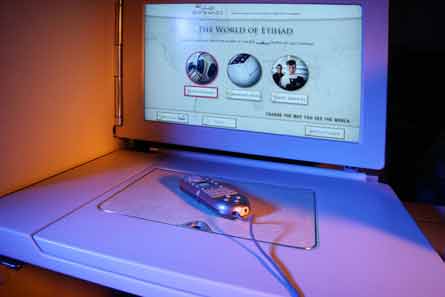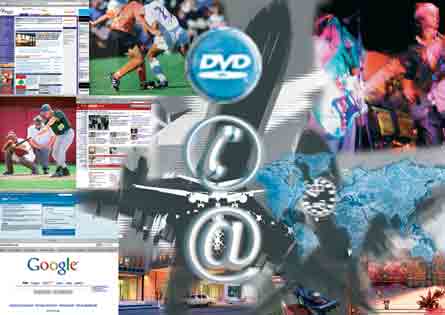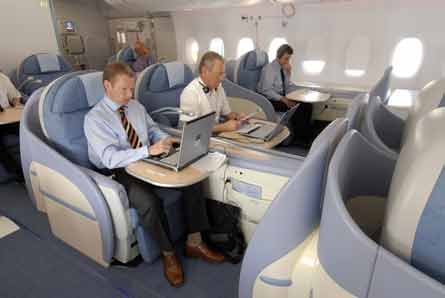As Airbus and Boeing advance airliner designs, can their in-flight entertainment suppliers keep pace? New systems for the A380 and 787 are now being tested
In-flight entertainment (IFE) system manufacturers Panasonic Avionics and Thales are going through testing times with two major new aircraft programmes under way. Trials are being carried out on Airbus A380 test aircraft of Panasonic's eX2 IFE system and Thales's TopSeries i-5000 at the same time as development work is under way on two new wireless systems for the Boeing 787, Panasonic's X-Series Wireless and Thales's i-8000. All the systems are going through rigorous test and evaluation programmes to ensure they are mature and reliable when they enter service on the A380 at the end of this year and the 787 in 2008.
Both the Thales i-5000 and Panasonic's eX2 systems being offered on the A380 have been developed from proven IFE systems that have been in service for some time on other, albeit smaller, aircraft. The i-5000 is part of Thales's TopSeries family, which includes the i-2000, i-3000 and i-4000. Unlike earlier systems in the series, however, the i-5000 features a fibre-optic gigabit-capacity Ethernet backbone, replacing the 100baseT Ethernet on the i-4000. Enhancements include improved picture quality thanks to digital delivery, advances in storage medium and integrated processor technology, resulting in reductions in size, weight and power consumption compared with earlier interactive IFE systems, says Thales.
|
|---|
| Etihad Airways is one of a number of announced customers for Thales i-5000 on the A380 |
Use of the high-speed network means that components are reduced, which in turn cuts overall system weight and power consumption. The i-5000 seat box is smaller, lighter and requires less power than in the i-4000 system, for example, but it can serve four seats instead of three, says the manufacturer. Head-end servers for the i-5000 are the same size as those for the i-4000, but storage capacity is more than doubled, cutting the number of servers required on the aircraft. Improvements in integrated processor technology, meanwhile, have cut video display weight by 40% and power consumption by 30% compared with earlier systems.
The i-5000 will offer audio- and video-on-demand to every seat on the A380, in addition to a host of entertainment, communication and information applications including games, shopping, text/email, internet/intranet and in-seat power.
The i-5000 has been undergoing a rigorous test programme, in laboratories and on A380 test aircraft, for a number of years. Since 2004 a 550-seat test system has been up and running at Thales's Irvine, California, laboratory. Airbus approved the system design following laboratory tests in August 2004. The aircraft manufacturer has had its own i-5000 test laboratory running since last year.
Laboratory testing is ongoing, says Thales, while this year the system progressed to flight tests on A380 MSN002, which was the first aircraft to be equipped with a full cabin installation. The system recently passed a major testing hurdle when Airbus conducted a cabin virtual flight test on MSN002. For the test, the i-5000 was installed in 474 passenger seats and 15 crew areas and a 15h simulated flight was performed. The installation featured the IFE system in different configurations, delivering a wide range of entertainment, communication and information options.
Passenger testing
During the cabin test the passengers were required to put the IFE system through its paces, using it for many hours at a time and repeatedly accessing the same functions to test stability and reliability. "The overall test was received very well. The system ran with no major issue," says Thales, adding that both it and Airbus were pleased with the results. Feedback from passengers was also excellent, it adds. No changes have been made to the system as a result of the latest test, says the manufacturer.
Tests of the IFE system are continuing on MSN002, with the aircraft due to embark on the early long flights (ELF) test programme with a full complement of passengers in early September. The ELF programme will include four test flights, lasting 7h, 10h, 12h and 15h, designed to test the cabin in airline operating conditions.
To date Thales has announced A380 orders for the i-5000 from Air France, Malaysia Airlines and Etihad Airways. Panasonic's eX2, meanwhile, is a development of the manufacturer's highly successful System 2000/3000/3000i seatback IFE for widebody aircraft, combined with elements from the eFX system developed for narrowbody aircraft. Like the i-5000, it also benefits from technology innovations, including improvements in media management capabilities, a larger network than available previously and reductions in weight, size and power consumption. Better in-seat integration and reduced wiring, integrated distribution of entertainment over an Ethernet network, reduced- size seat boxes and distributed electronics incorporated in the display have all resulted in a 40% weight reduction compared with predecessor systems.
At the same time, increased system bandwidth offers an almost limitless variety of entertainment and information options, according to Panasonic, including audio- and video-on-demand, games, electronic books, audio books, flight information, live text news, destination information, email, internet/intranet, telephony and in-seat power. Panasonic's A380 announced customers to date include Emirates, EVA Air and Qantas. A380 launch customer Singapore Airlines has selected Panasonic IFE hardware for all its previous aircraft, although it has not revealed its IFE system selection. Panasonic says it has "many additional sales of eX2 and more A380 programmes secured", which it is unable to talk about.
|
|---|
Like the i-5000, the eX2 has undergone extensive testing. System design was finalised in 2004 and prototype equipment has been tested in Panasonic's laboratories since that time. Airbus has also been operating an eX2 test rack in A380 configuration at its Hamburg laboratories since 2004, while a full A380 test rack is also operational at Panasonic's California facilities. Laboratory testing will continue. "These systems have so much software we never stop testing, especially the different configurations and user interfaces, which vary by airline customer," says David Bruner, Panasonic director strategic product marketing.
System refinements
The EX2 system is installed on A380 MSN007, which will undertake the 300h of route proving necessary for type certification from later this year. "Refinements" have been made to the system as testing has progressed, says Bruner. "I would say we have all the usual refinements going on as the eX2 prepares to enter service. There are always mechanical refinements, aesthetic refinements and software refinements," he adds.
Although the flight-test programme is not yet complete, Airbus says that, in general, testing to date has shown the new IFE systems to be "more stable" than older systems. With 500km (310 miles) of wiring on the A380, which has exacerbated the latest delays in the programme, the European manufacturer is not surprisingly evaluating wireless IFE systems for the future. It adds, however, that "even wireless LAN has its own limits".
Boeing has insisted on wireless IFE systems for its new 787, and Panasonic and Thales have responded with the X-Series Wireless and i-8000, respectively. The wireless requirement was based on airline customers' need for flexibility in aircraft interiors, says Sean Sullivan, Boeing's 787 cabin systems manager. "The 787 design is based on giving customers interior flexibility never before available on a twin-aisle commercial aircraft. Wireless IFE is a key element in the overall 787 strategy of allowing for rapid interior reconfigurations - moving seats and lavatories, for example - and upgradeability," says Sullivan.
Wireless benefits
Boeing believes that a wireless IFE system will result in benefits in a number of areas, primarily easier cabin reconfiguration. Quick interior changes will allow aircraft to be easily swapped between different airlines, routes and types of service, such as charter and scheduled. Boeing is also using the wireless opportunity to define standardised installations - a long-requested desire of airframe manufacturers and airlines. Boeing's design on the 787 will integrate passenger connectivity with the IFE, resulting in fewer line replaceable units in a common system as opposed to separate, isolated systems used previously. All IFE head-end equipment on the 787 will be housed in a new sealed module - the cabin equipment centre (CEC) - in the bays located forward of the nose gear and aft of the wing.
The CEC will have identical external interfaces, allowing an airline to change the IFE system without making any changes to aircraft wiring or structural modifications, says Sullivan. IFE suppliers are designing their LRUs to a common design specification, including seat hardware, which means they will easily be able to change IFE systems.
The industry's initial interest in wireless systems was sparked by potential weight savings, but it is the flexibility and simplicity benefits that are attracting attention. Boeing says that weight benefits from a wireless system will depend on specific customer configuration, but overall the manufacturer expects only a "modest weight benefit" over a wired IFE system.
Thales was the first IFE manufacturer to gain approval of its system for the 787 in September 2005. The i-8000 retains many of the features of i-4000 A/VOD system, but is wireless. It includes innovations in a number of other technologies, says Thales, including the fact that it supports MPEG 4 content and has a greater capacity and faster servers than previous systems, which allows it to provide data to more passengers, while its architecture means that new capabilities can easily be added.
Thales has been working with Boeing on wireless developments since 2004 and has tested a wireless system on a widebody. At the beginning of this year the IFE manufacturer passed the system requirements review milestone in the 787 programme and the next stage will see detailed laboratory testing followed by flight testing.
Panasonic's X-Series Wireless system was approved for the 787 last November. The system is a wireless version of the X-Series platform, sharing many of its components, but distributing A/VOD and broadband data to passengers over a high-speed, secure wireless distribution network.
Boeing's experience of new IFE systems in the past has not always been a happy one, with the introduction into service of the 777 plagued with reliability problems with its GEC Marconi IFE system. The manufacturer concedes that the 787 is based on "bold new technologies, including several wireless systems", but it understands the risks involved. "Boeing manages all new technologies using risk management tools. These tools allow Boeing to manage risk by providing management visibility of each risk and a plan to resolve these issues," says Sullivan.
The aircraft manufacturer says it has performed thousands of wireless tests to understand the technology, which have helped it identify issues early in the design process and to resolve any issues that may arise. It has also performed wireless tests in multiple aircraft types and has worked with a number of universities to gain a thorough understanding of the technology.
|
|---|
| The i-5000 was recently put through its paces on the A380 cabin virtual flight test |
Detailed design
Boeing and its IFE suppliers are following a detailed testing programme for the systems. The IFE suppliers have conducted limited laboratory testing, but full-scale laboratory testing is to start imminently. Architectures for the systems are firm and detailed design on system equipment has begun, says Boeing. Prototype hardware is to be delivered late this year or in early 2007 for detailed testing. Thales and Panasonic are building their own testing laboratories for their systems in full 787 configuration to verify performance, integrate different LRUs and to develop and test software, says Boeing.
"Parts of the i-8000 are in design and other parts are ready to start testing," says Thales. "Our intention is to start lab testing within the next few months in one of our technical centres in Irvine. We are starting to bring into our facility aircraft pieces and system parts that will make up the lab," Thales adds.
Panasonic is expanding its Lake Forest, California, engineering laboratories to support a full-scale 787 IFE configuration to put the X-Series Wireless through its paces. "We have done large-scale testing on prototype hardware but not in the exact 787 configuration as parts of that configuration are still in definition. Because of the challenge of delivering eX2 functionality over a wireless network, testing and tuning will continue right up until the point of delivery," says Bruner.
Boeing laboratories in Seattle, meanwhile, will be used primarily to test interfaces with aircraft systems, verify data load and health management. Laboratory testing for both IFE suppliers will then progress to flight testing. The third 787 test aircraft is to be equipped with the i-8000 and X-Series Wireless - one at a time - for flight tests in the second half of next year to verify functionality and system operation.
The IFE suppliers are confident of meeting Boeing's schedule and requirements. "We are working closely with Boeing on testing our system according to the schedule. We do not see any reason for delays," says Thales. Panasonic adds: "As with all new aircraft programmes the aggressive schedule and aggressive system requirements generate concern on the part of the airlines that the system will be ready in time for delivery. Boeing and Panasonic are working closely together to make sure we have a system ready for service delivery."
With 787 orders now topping 360 from 25 customers, the programme already has huge potential for both IFE system manufacturers. Customers are due to start making official selections of their IFE systems in September. Boeing says it has hosted several airline forums to help airline customers and IFE suppliers share information and to help foster communication.
Thales says it has experienced strong demand from potential customers for demonstrations of the i-8000. "We are taking a seat demonstration to many of the main target customers that are making decisions in the near term," says the manufacturer.
High quality
Airlines have expressed "great interest" in wireless IFE, says Sullivan. "Customers have been insistent that our wireless IFE must perform equivalent to their wired IFE, or better. The passenger expectation for IFE is indifferent to wired or wireless technologies and our task is to develop systems that provide high quality and high system availability. Passengers will not be sympathetic to excuses if the IFE does not work and we must make the use of wireless technology seamless in the delivery of entertainment to passengers," says Sullivan.
Boeing believes that through the work it is doing with its supplier partners, the bad IFE experience when the 777 entered service will not be repeated with the 787. Sullivan says: "We are confident our testing plans and risk mitigation techniques will allow for trouble-free IFE entry into service of the 787." ■
Source: Flight International



















